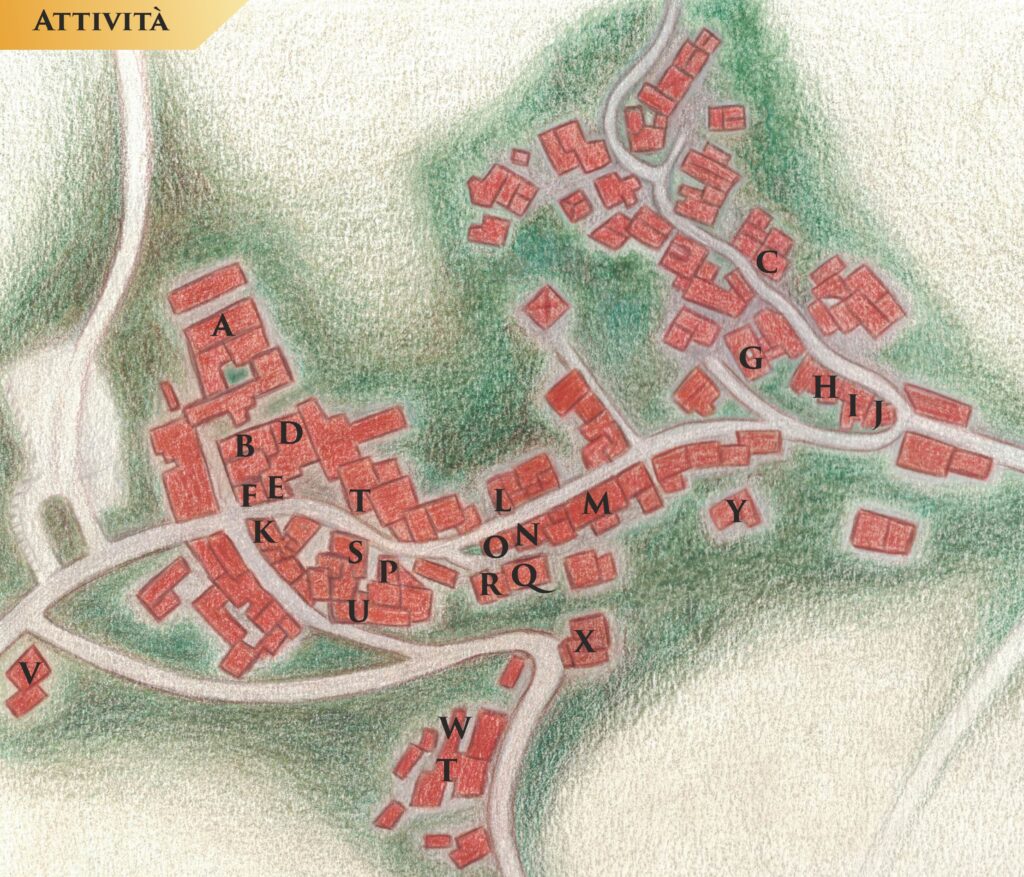In the first half of the last century, Montemagno was a very lively village with numerous commercial, artisanal, agricultural, recreational, and cultural activities.
Commercial and artisanal activities included a butcher shop (F), a bakery (H), four grocery stores (K, U, P, and C), two haberdasheries (M and S), a dairy (L), a fruit vendor (N), two barbers (D and M), a carpenter (Q), two blacksmiths (T), a tailor (A), and a cobbler (R), all of whom worked in their own homes. Additionally, there were several masons present in the village.
Of the four grocery stores, one (K) was a consumer cooperative managed by a shopkeeper who was entitled to a percentage of the profits earned as compensation. The other three grocery stores (U, P, and C) also served as bars, as each had a space where the village men could gather in the evenings and on holidays to converse, play cards, and enjoy coffee, wine, or other spirits. Particularly, store U also had a bakery for bread production and, on summer Sundays, prepared ice cream that was then sold throughout the village streets from a horse-drawn cart. The other grocery store (P), known as Appalto, also sold Monopoly goods (salt and tobacco) and, upon request or reservation, acted as a tavern. The bread sold by stores K and P was produced outside of Montemagno, while store C used locally baked bread from the village bakery (H).
In addition to the three bars, other recreational and cultural activities were present: four recreational clubs (B, E, I, and O), including a hunters’ club (I); a local drama company that had been operating since the beginning of the last century, managing to establish a theater (W) in the still-existing premises for its events. The drama company’s activities were well-followed and appreciated by both the villagers and residents of nearby towns.
Two oil mills (X and Y) were also important for the village’s economy: Y was the Pisticci Oil Mill of the Naldini farm, active until the 1960s and still retaining some original elements; X belonged to the Ribecai farm, later Marconi, active until the early 2000s. Both were situated along the Zambra stream of Montemagno as they were water-powered. Given the variable flow of the Zambra stream throughout the year, water storage areas were connected to the mills through the so-called “gore” that ensured a constant water flow to activate the millstones.
Additionally, many families owned flocks of sheep, providing wool, meat, milk, and cheese. The sheep primarily grazed in the olive groves, contributing to soil fertility and the selection of plant species.
Finally, there was a nursery school (G) and some welfare activities for the residents: a mutual aid stretcher service (J), a workers’ mutual aid society (O), later converted into a recreational club, and the (V)..

Illustration by Silvia Pasqualetti.
Text partially adapted from a study by Professor Giancarlo Del Corso.
